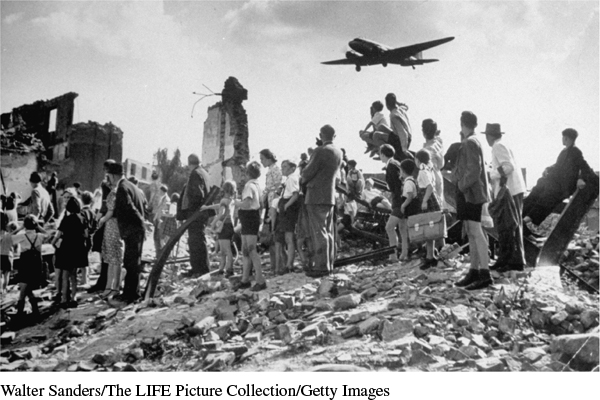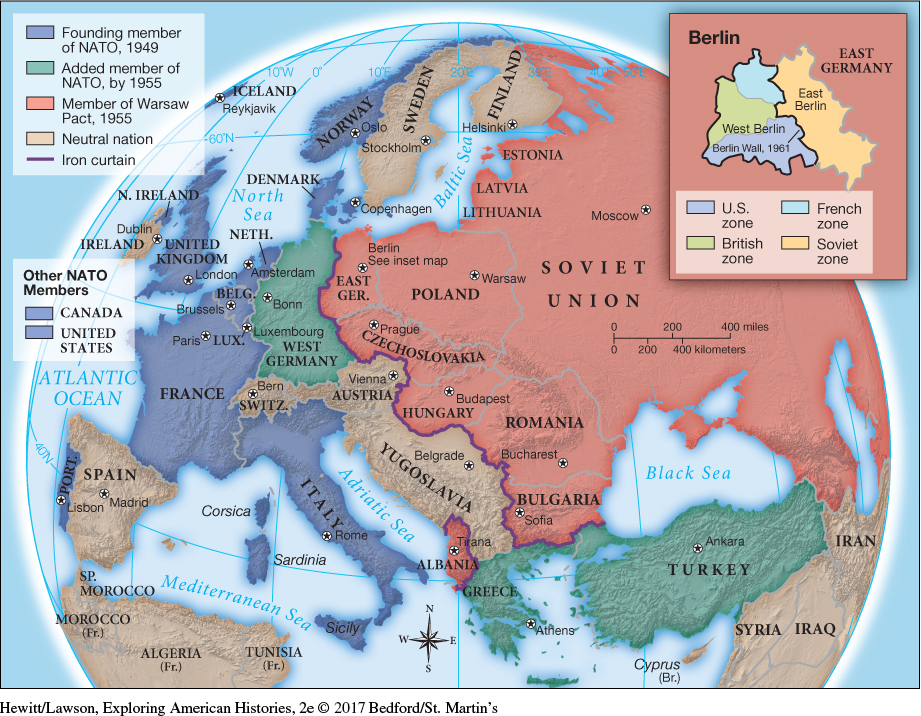Military Containment
The New Deal and World War II had increased the power of the president and his ability to manage economic and military crises. The Cold War further strengthened the presidency and shifted the balance of governmental power to the executive branch, creating what has been called the imperial presidency.
As the Cold War heated up, Congress granted the president enormous authority over foreign affairs and internal security. The National Security Act, passed in 1947, created the Department of Defense as a cabinet agency (replacing the Department of War), consolidated control of the various military services under its authority, and established the Joint Chiefs of Staff, composed of the heads of the army, navy, air force, and marines. To advise the president on military and foreign affairs, the act set up the National Security Council (NSC), a group presided over by the national security adviser and consisting of the secretaries of state, defense, the army, the navy, and the air force and any others the president might appoint.
In addition to this panel, the National Security Act established the Central Intelligence Agency (CIA) as part of the executive branch. The CIA was given the responsibility of coordinating intelligence gathering and conducting espionage abroad to counter Soviet spying operations. Another new intelligence agency, the National Security Agency, created in 1949, monitored overseas communications through the latest technological devices. Together, these agencies enhanced the president’s ability to conduct foreign affairs with little congressional oversight and out of public view.
By 1948 the Truman administration had decided that an economically healthy Germany, with its great industrial potential, provided the key to a prosperous Europe and consequently a depression-proof United States. Rebuilding postwar Germany would also fortify the eastern boundary of Europe against Soviet expansion. In mid-1948 the United States, the United Kingdom, and France consolidated their occupation zones, created the Federal Republic of Germany (West Germany), and initiated economic reforms to stimulate a speedy recovery. The Soviet Union saw a strong Germany as a threat to its national security and responded by closing the access roads from the border of West Germany to Berlin, located in the Soviet zone of East Germany, which effectively cut off the city from the West.
The Soviet blockade of West Berlin turned the Cold War even colder. Without provisions from the United States and its allies in West Germany, West Berliners could not survive. In an effort to break the blockade, Truman ordered a massive airlift, during which American and British planes transported more than 2.5 million tons of supplies to West Berlin. After nearly a year of these flights, the Berlin airlift ended in the spring of 1949 when the Russians lifted the blockade.

Meanwhile, in November 1948 Truman won election for a second term. He drew opposition from critics on his left and right for his handling of the Cold War, challenging both his aggressiveness toward the Soviets and his increased spending for containment. Nevertheless, most Americans stood behind his anti-Communist foreign policy (see “Truman, the New Deal Coalition, and the Election of 1948” in chapter 25) as the Cold War continued.
The two superpowers kept the conflict alive when each fashioned military alliances to keep the other at bay. In April 1949, the United States joined eleven European countries in the North Atlantic Treaty Organization (NATO). A peacetime military alliance, NATO established a collective security pact in which an attack on one member was viewed as an attack on all (Map 24.1). In 1949 the Russians followed suit by organizing the Council for Mutual Economic Assistance to help their satellite nations rebuild and six years later by creating the Warsaw Pact military alliance, the respective counterparts in Eastern Europe to the Marshall Plan and NATO.

Amid the growing militarization of the Cold War, 1949 brought two new shocks to the United States and its allies. First, in September the Russians successfully tested an atomic bomb. Second, Communist forces within China led by Mao Zedong and Zhou Enlai succeeded in overthrowing the U.S.-backed government of Jiang Jieshi and creating the People’s Republic of China. These two events convinced many in the United States that the threat posed by communism was escalating rapidly.
In response, the National Security Council met to reevaluate U.S. strategy in fighting the Cold War. In April 1950 the NSC recommended to Truman that the United States intensify its containment policy both abroad and at home. The document it handed over to the president, entitled NSC-68, spelled out the need for action in ominous language. “The Soviet Union, unlike previous aspirants to hegemony,” NSC-68 warned, “is animated by a new fanatic faith, antithetical to our own, and seeks to impose its absolute authority over the rest of the world. It is in this context that this Republic and its citizens . . . stand in their deepest peril.” NSC-68 proposed that the United States develop an even more powerful nuclear weapon, the hydrogen bomb; increase military spending; and continue to negotiate NATO-style alliances around the globe. Departing from the original guidelines for the CIA, the president’s advisers proposed that the United States engage in “covert means” to foment and support “unrest and revolt in selected strategic [Soviet] satellite countries.” At home, they added, the government should prepare Americans for the Communist danger by enhancing internal security and civil defense programs.
Truman agreed with many of the principles behind NSC-68 but worried about the cost of funding it. The problem remained a political one. Though the Democrats once again controlled both houses of Congress, there was little sentiment to raise taxes and slash the economic programs established during the New Deal. However, circumstances abruptly changed when, in June 1950, shortly after the president received the NSC report, Communist North Korea invaded U.S.-backed South Korea. In response to this attack, Truman took the opportunity to put into practice key recommendations of NSC-68.
Exploring American HistoriesPrinted Page 797
Exploring American Histories Value EditionPrinted Page 586
Chapter Timeline